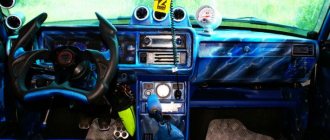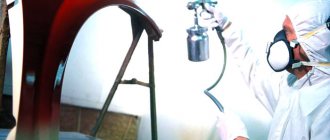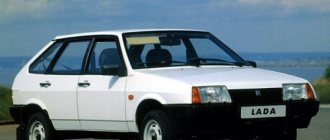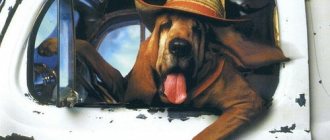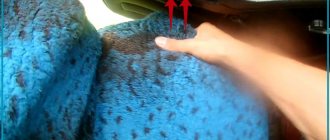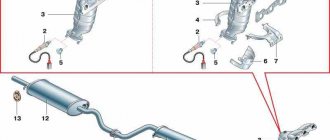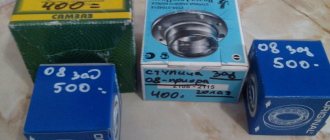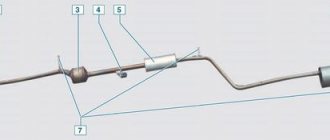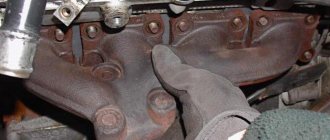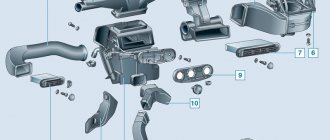Repair of the middle (side) pillar
Repair technologies, their choice after troubleshooting damage
To offer the customer an economical option for body repair of the B-pillar, a simple visual inspection is not enough for the experienced technicians of our car service center.
A small dent in the metal of the pillar may be due to damage to the welding points or the weld seam connecting the body element to the sills and roof. As a rule, such deformations are associated with a violation of the body geometry and require serious repairs. The technician can find out the correct technology for repairing the strut only after a detailed inspection and measurements of the parameters of the car body at the stand using factory control points. Internal damage, cracks, and metal tears may be discovered during repairs or when disassembling the rack. The significant length of the B-pillar increases the consequences of deformation. In case of side impacts, the curvature of the B pillar leads to changes in the geometry of the two doorways. The bending of the pillar disrupts the correct position of the rear door hinges and door locks.
In case of minor damage (dents, chips) that do not affect the metal structure, it is possible to use gentle methods for straightening the metal of the rack. Without additional painting, craftsmen use glue and vacuum extraction of metal. Deep dents in the profiled metal of the B-pillar are repaired using a spotter hood or manual straightening. Manual operations require disassembling the rack. In some designs, for manual straightening it is necessary to cut cutouts in the profile for wiring a special anvil into the cavity of the stand.
Repairs of complex accidents (with metal tears) and corrosion damage require disassembling the rack. At the same time, associated body elements (sills, load-bearing side members, connections to the roof) are repaired. When dismantling the rack, craftsmen drill out resistance welding points and cut off the welds. Before this, it is necessary to remove the car doors, disassemble the seats, insulate or disassemble the interior equipment.
After straightening and restoring the rack, installation involves:
- fitting the B-pillar on temporary fastenings, checking the geometry of door and window openings;
- adjustment of gaps, position of door hinges, locks;
- spot or semi-automatic electric welding in compliance with factory technologies;
- cleaning of weld points and seams;
- anti-corrosion treatment of internal surfaces;
- primer, grinding of external surfaces;
- assembly of all removed body and interior elements;
- local painting of the pillar or the entire car;
- body polishing.
The experience and skill of the painter requires precise selection of the shade of car paint when painting the rack locally. After the work of an experienced specialist, the color of the rack is indistinguishable from the tone of the faded enamel of the entire body.
Ordering a rack repair in our car service: advantages and bonuses
In the body shop of our car service there are no restrictions on the complexity of repairing deformed struts. When accepting a car for repair, the technicians offer customers cost-effective work options, explain the need to use a specific technology, and discuss repair estimates with the customer. The presence of the client during measurements and the reflection of all repair operations in the documents eliminate possible disputes and disagreements.
Our regular customers in their reviews note the real benefits of the order:
- transparency of the estimate;
- highly qualified and experienced body shop specialists;
- speed of work;
- affordable prices;
- strict compliance with contractual obligations;
- own guarantees for the quality of repairs;
- a wide range of related work;
- careful attitude towards the customer's car.
When ordering body work from us, you can be sure of the completeness, technological correctness and durability of the repaired body parts. For our customers, it is convenient to receive a car for work in the evening (up to 22 hours), cumulative discounts, and a simple ordering procedure (phone call or electronic application).
Body pillars
When developing an automobile body structure, engineers pay attention to a lot of factors that further determine the aerodynamic qualities of the car and its crash stability. The body is attached to the car frame. If we draw analogies with the human body, then the body pillars can be compared to the spine.
What are body struts needed for?
Surely many people have seen cars after an accident. Sometimes they are rolled up so much that it is difficult to identify a vehicle in this pile of scrap metal. However, one cannot help but notice that depending on the impact, the body evenly begins to turn in one direction or another - this is the merit of the racks. If they weren’t there, the body would have compressed in a collision like a deflated ball.
Depending on the type of car body, the number of pillars and the shape of each of them changes. Initially, cars of a collapsible design dominated, each rack being a separate element. But with the development of the automotive industry, the number of parts is constantly decreasing. For example, the side panel of the Audi A8 consists of 8 parts, while the side panel of the Audi A2 is made as a single piece.
The design of a classic sedan can be divided into rear, middle and front pillars, each of which performs several functions.
Rack design:
- outer part;
— overlay;
The outer part has the shape of a beam, the overlay follows the shape of the outer part, but has holes and is welded to the flange of the outer profile. The lower part of the pillar is connected to the body sill, and the upper part is connected to the roof.
Types of racks and their features
The B-pillar is a body element, the condition of which directly affects the condition of the car's doors and roof. When the pillar deforms, the door axes shift and the roof deforms.
It is the middle pillar that suffers the most in a side impact. If the rack is slightly damaged, it can be repaired, otherwise it will be replaced.
The black sheep among cars is the Ford S-Max, which has no B pillars. Ford engineers made this decision to install sliding doors, which are made of high-strength steel. The result is a minivan with a doorway width of about one and a half meters. According to engineers, the B-pillars are integrated into the doors.
The A-pillar is an element that prevents body deformation during a frontal collision. The lower part of the pillar is connected to the roof of the car, the lower part is connected to the threshold. To increase strength, reinforcements and pads are used.
The C-pillar changes shape more often than others. Depending on the body type, the rear pillar may differ in length and method of attachment. The most common rear strut shape is the Hofmeiter bend.
The first curved shape for the rear pillars was used for BMW cars in 1961. This form is used for the rear pillars and carries a functional load - strengthening the rear roof pillar, which allows you to obtain acceptable strength and maintain the external lightness of the structure.
How racks can provide security
The main task of the designers is to give the racks optimal impact mechanical strength. The determining factor for achieving the required characteristics is the strength of the connection of the roof cross beam and sills with the vehicle pillars. This mechanical unit must be capable of transmitting forces of at least 2 tons. In addition, attention is paid to the materials from which the racks and reinforcing elements are made. If manufacturers figured out the material quite a long time ago, the connection of these elements is still subject to changes.
Safety is achieved through the use of high-strength materials and structural strengthening systems. Sheet steel is used, which has a high elastic limit and linings, which strengthen the welds and relieve some of the stress during impact. The car's pillars are hollow inside, which allows them to absorb energy during a collision. The presence of 3 pairs of car body pillars allows you to withstand serious collisions, ensuring the safety of the driver and passengers.
What can cause damage to the racks?
In addition to a frontal collision, there are many other factors that can lead to damage to the body pillars. Racks, being a structural element of the body, suffer from similar problems. Every day, the body takes on loads from the weight of the driver and passengers, which leads to gradual deformation, aggravated by driving on uneven roads. Also, the struts are destroyed by incorrect operation of the car suspension and corrosion, which is inevitable for any car. On average, the service life of the body, respectively the racks, is 10-15 years. In order for the racks to maintain their functionality, you need to monitor the general condition of the car and choose a speed mode depending on the quality of the road surface. In the event of an accident, the racks must be repaired or replaced.
Replacing shock absorbers, struts and supports
The cost of replacing shock absorbers is largely determined by the type of suspension. It is important to distinguish between a double wishbone suspension and a McPherson strut type design. In the second case, repair of shock absorbers will be estimated based on the total cost of work on removing the front struts, disassembling them, replacing the front shock absorber, reassembling the strut and installing it.
The rear multi-link suspension may also require replacement of the rear suspension struts. For a dependent suspension scheme, replacing the rear shock absorbers is usually easier. Below are typical cases of suspension repair by replacing shock absorbers.
Replacing front shock absorbers (with a double-lever design):
- the operation is performed on a “pit” or a lift (in this case, there is no need to raise the car high - for ease of replacement, the suspension should be slightly compressed!);
- open the hood, unscrew the upper fastener of the rod through the hole in the engine compartment (to secure it from turning, you need to hold the rod with a special key or thin pliers);
- completely remove the rod fasteners, the engraving and support washer of the cushion - then you can remove the upper shock absorber support pad itself;
- under the lower suspension arm, unscrew the two nuts securing the shock absorber support (be careful not to lose the self-tensioning washers!);
- the old shock absorber is removed downwards - through the window of the lower suspension arm;
- With the shock absorber removed, the rubber support pad is removed from the rod;
- using two keys, unscrew the bracket fastening nut (the bolt head is held by the second key) - and remove the entire bracket;
- the removed bracket can be moved to another shock absorber - if the new unit is supplied without it!
- the new shock absorber is installed in the reverse order (before installation, it is recommended to extend its rod as much as possible! And put a washer, cushion, and nut on the upper end in advance);
- the second shock absorber of the front suspension is changed in a similar way.
Replacing McPherson-type front struts: Since the McPherson strut includes a shock absorber, a front suspension spring (with two support cups), a telescopic rod, as well as a number of other parts, replacing the shock absorber will involve complete removal of the strut and its disassembly. Very often this operation is called “replacing the shock absorber strut”, or simply “replacing the strut” - although it still means replacing the shock absorber. The work algorithm looks like this:
- the car is placed on a level surface or hung on a lift;
- the hood opens, the nut securing the support to the strut is slightly loosened (in this case, the shock absorber rod should be held with a second wrench);
- the handbrake is tightened, the wheel bolts are loosened;
- the desired side of the car is raised with a jack (if the operation is not carried out on a lift);
- the wheel is removed, the front brake hose is carefully moved to the side (you should first remove it from the holder on the rack);
- To make it easier to replace the shock absorber strut, it is recommended to thoroughly clean all bolts and nuts from dirt (especially the assembly that secures the strut to the steering knuckle) and treat them with WD-40 lubricant;
- the fastening of the steering tip to the strut arm is unscrewed, using a hammer (or better yet, a special puller!) the tip is knocked out of the strut;
- the nuts connecting the strut and the steering knuckle are unscrewed from below (it is better to use union heads with a knuckle);
- certain difficulties may arise with removing the bolts from the mounting sockets - they should be carefully knocked out with a thin metal rod, periodically unscrewing the bolt from the reverse side;
- finally, under the hood, the three nuts securing the strut to the body support cup are unscrewed (do not completely unscrew the last nut so that the strut does not fall down!)
- When the fastening elements of the strut to the knuckle are removed, you can finally unscrew the upper nut securing it to the body cup and remove the strut.
To replace the shock absorber, the strut must be disassembled:
- using a coupler, you need to compress the strut spring (while placing the legs of the couplers evenly so that the spring does not warp);
- as soon as the spring moves away from the support plate, you can unscrew the upper nut;
- the strut support is removed (together with the bearing and rubber cushions - so as not to assemble this unit piece by piece when installing a new shock absorber);
- the compressed spring is removed (if necessary, it can be replaced with a new one - simultaneously with replacing the strut shock absorbers);
- The boot and bumper are removed from the strut rod (they are fitted with an interference fit - you need to apply a little force!);
- a bumper and boot (removed earlier or also new) are put on the new racks;
- a new spring is installed (before installation, it is also tightened to fit under the support cups of the strut);
- the spring is put on the stand - you need to make sure that the lower coil sits exactly on the support belt!
- the upper support cup is turned over - a bearing is placed on it (there is always a “top” mark on the outer ring of the bearing);
- the bearing is covered with a cup, an elastic band is installed on top - the resulting “pact” is put on the strut rod with a new spring and tightened with a nut (in this case, the strut rod must be kept from turning);
- When tightening the nut, you must ensure that the upper coil of the spring lies exactly along the perimeter of the support cup!
- the assembled module of the new strut is installed on the car in the reverse order of removing the strut (see above).
As you can see, the cost of replacing struts (as well as the list of necessary work) may be higher than the cost of replacing shock absorbers on a double-wishbone suspension.
It should be noted that the rear multi-link suspension also contains struts. Accordingly, the work of replacing them will be somewhat more complicated (compared to replacing the rear shock absorbers of a dependent suspension - this is usually much simpler).
